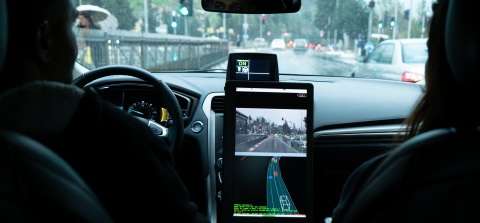Despite Uncanny Similarities, Nvidia’s SFF Fails to Match Mobileye’s RSS, Which Is the Leading AV Safety Model
JERUSALEM — (BUSINESS WIRE) — March 25, 2019 — The following is an opinion editorial by Prof. Amnon Shashua of Intel Corporation.
This press release features multimedia. View the full release here: https://www.businesswire.com/news/home/20190325005575/en/

A photo from December 2018 shows the interior cabin of a Mobileye autonomous vehicle as it maneuvers through traffic in Jerusalem. Mobileye, an Intel company, is the leader in assisted driving and a pioneer in the use of computer vision technology to save lives on the road. The company, based in Jerusalem, became part of Intel in 2017. (Credit: Mobileye)
As we march toward a driverless future, we at Mobileye have continued to lead the industry with new innovations that will not only enable fully autonomous vehicles (AVs), but will also make human-driven cars safer than they have ever been. Over the years, I am proud that we have achieved many industry firsts: camera and radar fusion in 2007, pedestrian-detection warning in 2010, camera-only forward-collision warning in 2011, camera-only automatic cruise control (ACC) in 2013, hands-free assist in 2015, crowd-sourced HD-mapping in 2016, the Responsibility-Sensitive Safety (RSS) safety model in 2017 and, most recently, a “vision zero” horizon through a novel preventive system using RSS.
It is said that imitation is the sincerest form of flattery, and our innovations have not gone unnoticed with many embracing the same concepts that we pioneered. One industry player in particular habitually follows our lead, and today I would like to set the record straight on its latest imitation.
More: Autonomous Driving at Intel | Mobileye News
Let us consider the recent past. After Mobileye announced the world’s first crowdsourced mapping technology – Road Experience Management™ (REM) – in 2016, Nvidia announced a solution the following year that claimed to do the same. When Mobileye coined and introduced L2+ in 2017 as a new category of driving automation that uniquely applied our REM technology to driver assistance systems, again Nvidia followed suit and announced its L2+ offering in 2019.
Our most recent innovation, RSS, was published in an academic paper in 2017. We openly shared all the technical details and mathematics behind RSS because we believe that the safety of automated vehicles should not be proprietary, and that the industry should collaborate with governments on what it means for an AV to drive safely.
The response to and support of RSS has been tremendous. Baidu and Valeo have publicly signed on. China ITS has approved a work group tasked with standardizing RSS for the China market. And we have engaged with governments and standards organizations around the world on RSS. What’s more, dozens of research papers have cited RSS, contributing to the public discourse on this important topic.
We’ve always said that we believe RSS is an excellent starting point for verifiable safety assurance of automated vehicle decision-making. We’ve openly invited the entire industry to contribute their ideas on how to improve RSS. We were pleased when Nvidia heeded this call and reached out to us in 2018 about a collaboration on AV safety. We were puzzled when Nvidia backed out of the proposed partnership.
Imagine our surprise last week when Jensen Huang, CEO of Nvidia, announced a “first-of-its-kind” safety model for AVs. Curious to see what “first-of-its-kind” innovation Nvidia had created, we eagerly read the publicly released white paper about Safety Force Field (SFF), only to have the eerie feeling that we were looking in the mirror.
If imitation is the sincerest form of flattery, then Nvidia must think very highly of us. Based on the information that has been made available, it is clear Nvidia’s leaders have continued their pattern of imitation as their so-called “first-of-its-kind” safety concept is a close replica of the RSS model we published nearly two years ago. In our opinion, SFF is simply an inferior version of RSS dressed in green and black.
At Mobileye, we believe in technology innovation, not linguistic innovation. We have openly invited and are enjoying active collaboration with industry and government partners around the globe. It is unfortunate that rather than collaborate with us, Nvidia felt it necessary to follow us yet again, creating confusion where there could have been cohesion. Mobileye has invested enormous resources to develop RSS, and Mobileye has obtained intellectual property rights to protect these investments.
To illustrate Nvidia’s latest attempt to emulate Mobileye’s technology leadership, we have conducted a full comparison of the two approaches on the Intel Newsroom.
Prof. Amnon Shashua is senior vice president at Intel Corporation and president and chief executive officer of Mobileye, an Intel company.
About Intel
Intel (NASDAQ: INTC), a leader in the semiconductor industry, is shaping the data-centric future with computing and communications technology that is the foundation of the world’s innovations. The company’s engineering expertise is helping address the world’s greatest challenges as well as helping secure, power and connect billions of devices and the infrastructure of the smart, connected world – from the cloud to the network to the edge and everything in between. Find more information about Intel at newsroom.intel.com and intel.com.
Intel and the Intel logo are trademarks of Intel Corporation in the United States and other countries.
View source version on businesswire.com: https://www.businesswire.com/news/home/20190325005575/en/
Contact:
Danielle Mann
973-997-1154
Email Contact